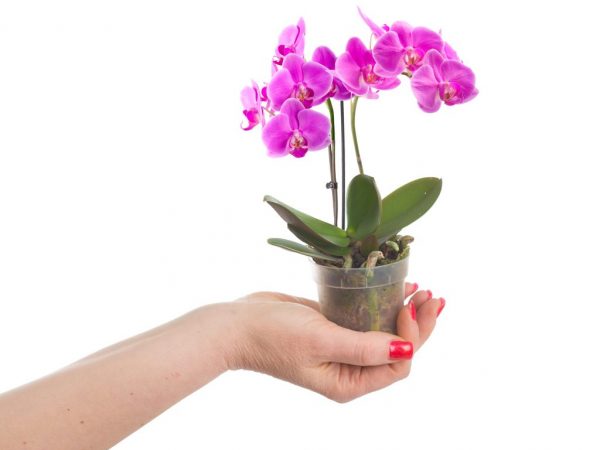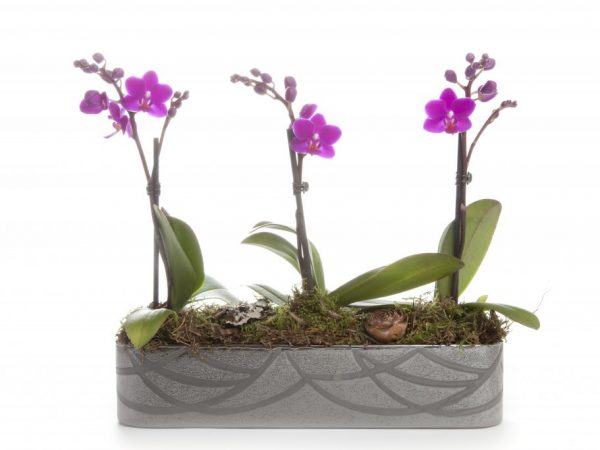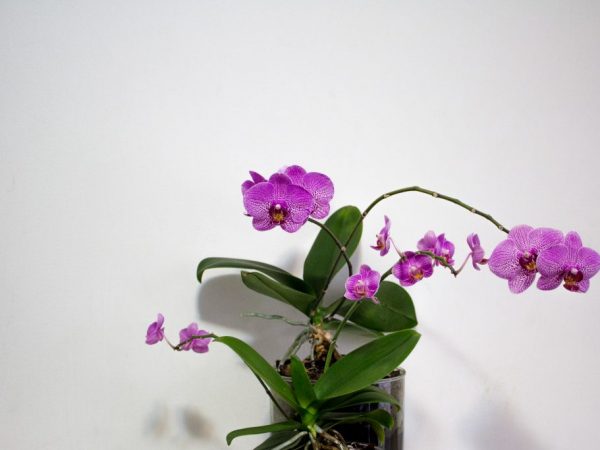Phalaenopsis mini orchid home care
miniature orchid varieties are bred by selection. These are low-growing plants that grow up to 15 cm in height. Mini phalaenopsis is a dwarf species with branched peduncles. The orchid blooms twice a year. Crop maintenance is minimal: irrigation, soil fertilization and proper lighting.

Phalaenopsis mini orchid home care
Description of the variety
The Phalaenopsis mini orchid is smaller than other types of orchids.
The culture blooms closer to winter - the average flowering duration is 3-4 weeks.
The buds are light, with small orange spots. The average size of an adult plant is no more than 20 cm. The height of a mini phalaenopsis depends on the care.
Variety variety
The variety has several types. These are beautiful dwarf crops that can be grafted at home.
Popular varieties:
- Luddemann;
- Pink dwarf variety;
- Phalaenopsis mini mark.
Luddemann has distinctive features: the sepals are larger than the petals. The diameter of the flowers is from 4 to 5 cm. On one peduncle, up to 7 inflorescences are formed, differing in variegated color.
The pink variety has abundant flowering. Up to 10 flowers are simultaneously formed in the peduncle. The white color of the sepals of the variety is combined with the pink tint of the petals.
One of the most popular and unpretentious care is the mini Mark Phalaenopsis variety. It grows at home and grows up to 17 cm in height. The color of the petals is white with pink spots.
Reproduction of orchids
The orchid reproduces vegetatively. The planting material (a small process) is separated from the flower.
For reproduction, the young shoot remaining after the flowering of the culture is immersed in the prepared soil. Wet sphagnum is a good option for germinating the material. A mini culture takes root within a year, so you cannot expect a quick growth of the offshoot. Roots are gradually formed in the root system, which, after a few weeks, are transplanted into a fertilized substrate.
Home care

An orchid needs a lot of light
Caring for the mini phalaenopsis orchid begins with choosing a suitable place. This should be a well-lit indoor corner without a lot of other flowers.
The variety needs:
- in regular watering;
- in constant temperature conditions;
- in soil fertilization (the amount of nutrients applied depends on the season);
- in a certain humidity.
Irrigation works
A dwarf orchid does not like excess moisture - if water stagnates at the root system, the flower will quickly wither.
Watering methods:
- normal - through a watering can;
- immersing the pot in a container of water;
- through ice cubes.
Watering can
Routine maintenance, including watering with a watering can, is harmful to the crop. If water gets on the leaves or flowers, yellow spots appear. So water is added only to the root part.
Submerging the pot in water
Submerging the pot in water gradually moisturizes the root of the plant. The flower pot is immersed in a previously prepared container with warm water. He is kept in this position for 15-20 minutes.
After the procedure, the excess liquid is drained, the pot is returned to the windowsill. Such care cannot be used if there is no additional drainage in the pot or a hole in the bottom.
Ice cubes for watering
For a closed container, the third method of watering is suitable, using ice cubes. An ice cube is laid on the moss, then they are placed on the top layer of soil at the root of the flower. For a week, 3 medium-sized water cubes are enough to completely moisten the soil.
Ice on moss does not melt immediately, so moisture gradually saturates the substrate. Watering work depends on how quickly the soil dries. If the soil dries quickly, the amount of added water is increased. The leaves are additionally sprayed with a spray bottle (at a distance of at least 15-20 cm from the culture).
Fertilizing the soil
Useful substances are introduced into the soil at least once a month. Too much fertilizer will weaken the root system. Fertilizers are diluted with water. For phalaenopsis dwarf orchids, nitrogen and mineral fertilizers are used.
Feeding scheme:
- during active growth, the soil is fertilized once every 2 weeks;
- in the cold season, when there is no flowering, fertilization is done once a month.
Immediately after fertilization, the soil is watered abundantly. For a dwarf culture, foliar feeding is useful: nutrients are sprayed on the green part.
Humidity level
Small orchids need high indoor humidity, especially in warm weather, when moisture quickly evaporates from the surface of the leaves. The optimum moisture content is 60-70%. This is difficult to achieve in living quarters.
Additional moisture is organized: a container with water is placed next to the pot, which makes it possible to increase the humidity. Water is sprayed near the flower, but so that excess moisture does not fall on the petals.
Young culture needs more moisture. The older the orchid, the less moisture it consumes.
Temperature control and lighting
A small orchid needs the right microclimate. A certain temperature regime allows the crop to grow rapidly and bloom twice a year.
The optimum temperature is from 20 ° C to 24 ° C. If in winter the pot stands near a battery or heater, the culture is watered and moistened more - an artificial microclimate is created.
At temperatures below 5 ° C, the flowers will fall off.
The lighting should be constant, but the petals fade from direct sunlight. The culture is placed on a windowsill on the south side of the room and covered with gauze or mesh. In winter, the orchid needs additional lighting. Lamps are used that extend daylight hours to 10-12 hours.
Orchid transplant
A transplant is a mandatory event after 3-4 years of active growth. For transplanting, choose pots that are several centimeters larger than the diameter of the old container. Too large pots cannot be taken, otherwise in the new conditions the rhizome of the dwarf culture will quickly be depleted.
The root system needs a special soil. To do this, use a substrate with pieces of bark and moss. The soil is poured into a new pot and well moistened with water. The discolored peduncles are carefully removed. After the plant is carefully removed from the old pots: it is important not to damage the rhizome.
Mini Phalaenopsis are cleaned of old roots. If there are traces of rot on them, the infected root is completely cut off. At the bottom of the new container, a small drainage from the bark is covered, and then the prepared substrate. The root system is immersed in a new pot and carefully sprinkled with soil and mineral fertilizers.
The first watering is carried out no earlier than after 10 days. If transplanted correctly, the stem will quickly grow and bloom.
Orchid diseases

Protect the orchid from rot
The mini orchid of the genus Phalaenopsis is prone to rot formation.Damage is caused by brown, black or gray rot. The symptoms of the appearance of such a disease directly depend on the conditions in which the culture grows (if the care is improper, the rot quickly spreads throughout the flower).
To save from rot, all affected areas of the plant are cut off with a clean tool. If more than 40% of the culture is affected, it will not be possible to save the orchid.
After cutting, the places of the cuts and the green part of the culture are sprinkled with coal powder. An alternative option is Bordeaux liquid, which helps to stop the fungal disease. After processing, the pot is sterilized, and the substrate is completely changed. After the disease, the plant becomes weak, so it needs additional care (correct temperature regime and watering). Fertilizer in the first weeks for the care of the crop is not used.
Leaves turn yellow or black
The appearance of dark spots or dry parts that quickly spread throughout the plant are the causes of powdery mildew, anthracnose or leaf blight. Each of these diseases leads to the death of the culture.
The flower turns yellow due to high humidity, therefore, before treatment, the plants change their basic care. If the leaves or roots are rotting, Fusarium rot is likely the cause. The culture is treated with Bordeaux liquid. If the roots are too damaged, the culture cannot be saved.
Orchid pests
It is impossible to care for mini-phalaenopsis without protection from pests. Insects not only spoil the appearance of the flower, but also lead to its complete wilting. The plant attacks:
- spider mite;
- whitefly;
- slugs;
- thrips.
Pests eat roots, foliage, flowers. If they live in the substrate, it is completely replaced.
The culture is transplanted into a new pot. The plant is soaked in water before transplanting so that the parasites get out. After that, it is dried and treated with a solution of potassium permanganate.
Leaves and petals fall
If leaves or petals fall, the scabbard is to blame. It is a pest that attacks the plant with columns. Soon, the orchid begins to throw off leaves or flowers. If the culture is not treated, it dies.
It is possible to get rid of the scale insect only mechanically: individuals are collected by hand. Additionally, a cotton wool moistened with an insecticide is used, with which the entire green part of the flower is wiped. After collecting the pests, the flower is treated with Fitoverm. At the end of the procedure, the substrate is completely changed, in which the parasite larvae can remain.
Conclusion
Phalaenopsis mini orchid is a beautiful dwarf flower. He needs to be properly looked after: watering, fertilizing the soil, replanting every few years. A culture blooms twice a year if the temperature and lighting conditions are correct in the room where it grows.
The dwarf culture is often sick, therefore, at the first symptoms: a change in the color or structure of leaves, petals, stems, they are treated.


